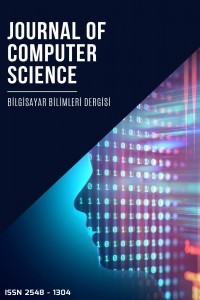Transformer Kodlayıcı ve Zaman-Frekans Görüntüleri Kullanarak Otomatik Uyku Evreleri Sınıflandırması
Uyku evreleri sınıflandırması, Derin öğrenme, Transformer kodlayıcılar, EEG sinyalleri, Polisomnografi, Zaman-frekans görüntüleri
Automated Sleep Stage Classification Using Transformer Encoders and Time-Frequency Images
Sleep stage classification, Deep learning, Transformer encoders, EEG signals, Polysomnography, Time-frequency images,
___
- Chen, P. C., Zhang, J., Thayer, J. F., & Mednick, S. C. (2022). Understanding the roles of central and autonomic activity during sleep in the improvement of working memory and episodic memory. Proceedings of the National Academy of Sciences, 119(44).
- Chriskos, P., Frantzidis, C. A., Nday, C. M., Gkivogkli, P. T., Bamidis, P. D., & Kourtidou-Papadeli, C. (2021). A review on current trends in automatic sleep staging through bio-signal recordings and future challenges. Sleep Medicine Reviews, 55.
- Figueiro, M. G., & Pedler, D. (2023). Cardiovascular disease and lifestyle choices: Spotlight on circadian rhythms and sleep. Progress in Cardiovascular Diseases.
- Fiorillo, L., Puiatti, A., Papandrea, M., Ratti, P. L., Favaro, P., Roth, C., ... & Faraci, F. D. (2019). Automated sleep scoring: A review of the latest approaches. Sleep Medicine Reviews, 48, 101204.
- Goldberger, A. L., Amaral, L. A. N., Glass, L., Hausdorff, J. M., Ivanov, P. C., Mark, R. G., Mietus, J. E., Moody, G. B., Peng, C. K., & Stanley, H. E. (2000). PhysioBank, PhysioToolkit, and PhysioNet - Components of a new research resource for complex physiologic signals. Circulation, 101(23): E215-E220.
- Hand, D. J., Till, R. J, (2001). A Simple Generalisation of the Area Under the ROC Curve for Multiple Class Classification Problems. Machine Learning, 45(2): 171-186.
- Iber, C. (2007). The AASM manual for the scoring of sleep and associated events: Rules, Terminology and Technical Specifications.
- Malekzadeh, M., Hajibabaee, P., Heidari, M., & Berlin, B. (2022, January). Review of deep learning methods for automated sleep staging. In 2022 IEEE 12th Annual Computing and Communication Workshop and Conference (CCWC), pp. 80-86.
- Ozen, G. Z., SULTANOV, R., Ozen Y., & Gunes, Z. Y. (2020). A Convolutional Neural Network Based on Raw Single Channel EEG for Automatic Sleep Staging. Sakarya University Journal of Computer and Information Sciences 3(2): 149-158.
- Rundo, J. V., & Downey III, R. (2019). Polysomnography. Handbook of Clinical Neurology, 160: 381-392.
- Sekkal, R. N., Bereksi-Reguig, F., Ruiz-Fernandez, D., Dib, N., & Sekkal, S. (2022). Automatic sleep stage classification: From classical machine learning methods to deep learning. Biomedical Signal Processing and Control, 77:
- Sri, T. R., Madala, J., Duddukuru, S. L., Reddipalli, R., & Polasi, P. K. (2022, Nisan). A Systematic Review on Deep Learning Models for Sleep Stage Classification. In 2022 6th International Conference on Trends in Electronics and Informatics (ICOEI), pp. 1505-1511.
- Vaswani, A., Shazeer, N., Parmar, N., Uszkoreit, J., Jones, L., Gomez, A. N., Kaiser, Ł., & Polosukhin, I. (2017). Attention is all you need. In Proceedings of the 31st International Conference on Neural Information Processing Systems, Long Beach, California, USA, pp. 6000–6010.
- Wolpert, E. A. (1969). A manual of standardized terminology, techniques and scoring system for sleep stages of human subjects. Electroencephalography & Clinical Neurophysiology, 26(2): 644-644
- ISSN: 2548-1304
- Yayın Aralığı: Yılda 2 Sayı
- Başlangıç: 2016
- Yayıncı: Ali KARCI
Gauss Filtreleme ve ResNET50 Modeli Kullanılarak Beyin Tümörlerinin Sınıflandırılması
Madde Tanıma Sistemlerinde Makine Öğrenmesi Metotlarının Kullanımı
Sayısal Global Optimum için Çift-Girişim Tabanlı İyileştirme Algoritmasının Yakınsama Analizi
İrfan SARIYILDIZ, Mehtap KÖSE ULUKÖK
Parametre Tahmini ve Bilgi Entropisi Kullanan Yeni Bir Dijital İkiz Tabanlı Arıza Teşhis Yaklaşımı
İlhan AYDIN, Emrullah AYDIN, Erhan AKIN
Muhammed Salih TATAR, Rabia KÖK, Aybars UGUR
Improved Reptile Search Algorithm for Optimal Design of Solar Photovoltaic Module
Davut İZCİ, Serdar EKİNCİ, Murat GÜLEYDİN
Yeşil Tedarikçi Seçiminde Hibrit Bulanık AHP ve Bulanık QFD Yaklaşımının Kullanılması
Candan UÇKUN, Nurdan DALGIÇ, Aytaç YILDIZ
Sağlık Hizmetindeki Robotlar İçin Blokzincir Destekli Görev Yönetimi: Webots Simülasyonu
Mehmed Oğuz ŞEN, Fatih OKUMUŞ, Fatih KOCAMAZ
Siber Güvenlikte T-Pot Honeypot Uygulanması: Kurumsal Ağ Üzerinde Örnek Durum Çalışması
